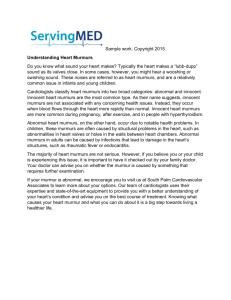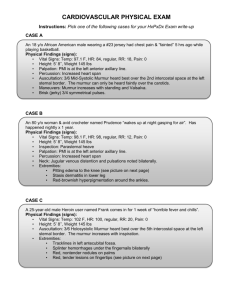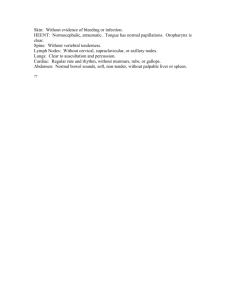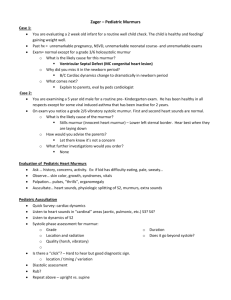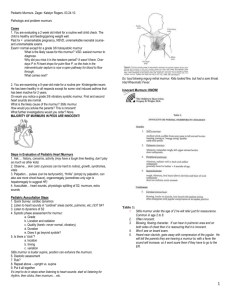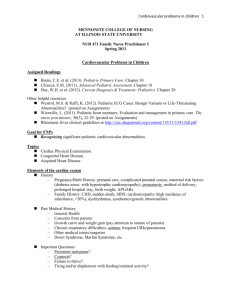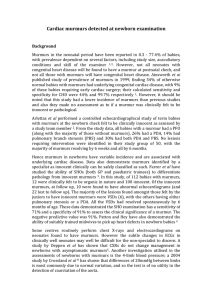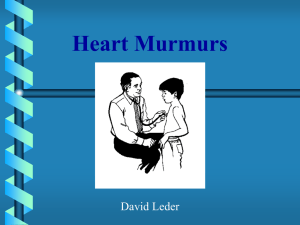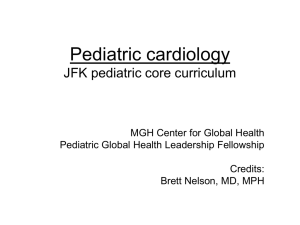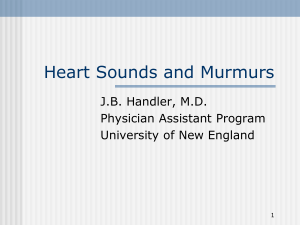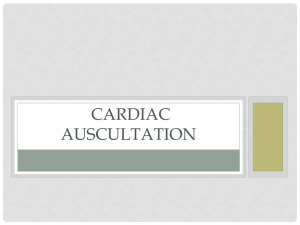Dynamic Ausculatation
advertisement
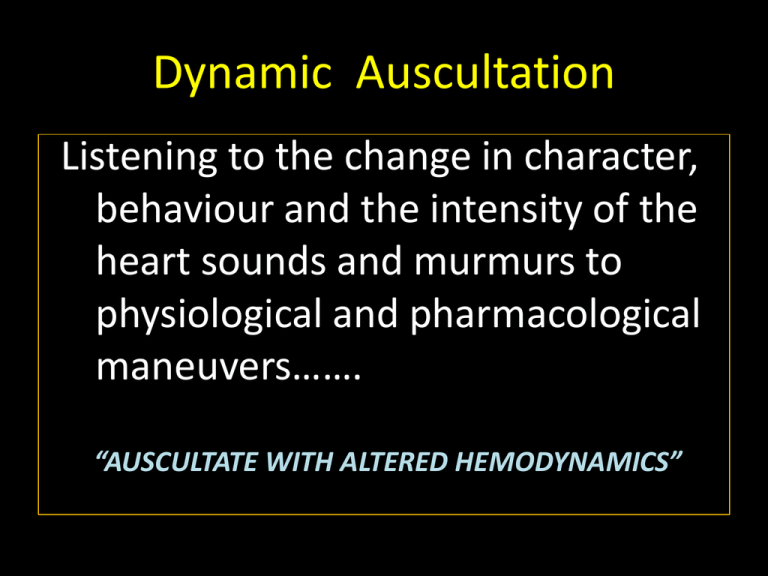
Dynamic Auscultation Listening to the change in character, behaviour and the intensity of the heart sounds and murmurs to physiological and pharmacological maneuvers……. “AUSCULTATE WITH ALTERED HEMODYNAMICS” Dynamic Auscultation • Source of murmur : Right Heart ~ Left Heart • Differentiate closely simulating murmurs Outflow ~ Regurgitatnt murmur • Differentiate flow murmurs from those of structural deformity : Austin Flint ~ MS • Differentiate Dynamic from Fixed Obstructions Maneuvres • • • • PHYSI(OLOGI)CAL Postural change Supine / L Lateral Standing Squatting Valsalva Handgrip Cycle length change PHARMACOLOGICAL • Amyl nitrite • Phenylephrine Position • Left lateral decubitus : Augments the murmur of MS, MR, Austin Flint, MVP & S1, LV S3 & S4 • Sitting & Leaning forward : ↑ AR murmur • Sitting with arms raised above the head : ↑ AR • Knee chest position : AR, Pericardial Rub • Passive leg raising : ↑ VR >↑ Right Heart events Respiration • Inspiration augments right sided events, as the venous return increases : TR & TS , PR & PS murmurs ; RV S3,S4 & TV OS S1 & S2 split widen. • Exception is PES – augmented in expiration # Preferably quiet respiration # Avoid apnea # Listen the first few beats # In erect posture if Venous pressure is high Carvallo’s sign • • • • Inspiratory accentuation of TR murmur Early systolic murmur > holosystolic Blowing quality > musical Absent in severe RV failure associated TS is severe • If venous pressure is very high, listening in upright posture may help Reversed Carvallo sign HCM with RVO obstruction - ? ↑ VR > widened RVO Respiration • Left sided events are better heard in expiration MR, MS, AS & AR murmurs LV S3 & S4, Mitral OS Click & murmur of MVP occur later @ PV – LA gradient increases > ↑ LV filling @ Lung overlap decreases @ Apnea for faint AR murmur Pms = mean systemic pressure; Ppc = pulmonary capillary hydrostatic pressure; Ppi = pulmonary interstitial hydrostatic pressure; Ptm = pulmonary capillary transmural pressure Abrupt standing • S2 split which may be wide, may narrow down , while the fixed split may persist • A2 OS interval widens – differentiates from wide split of S2 • All murmurs ( except MVP/HOCM) decrease • ESM of HOCM becomes louder and longer • Click occurs earlier, murmur becomes longer in MVP – loudness shows variable response Isometric Hand Grip HAND DYNAMOMETER Physiological changes of ISOMETRIC HANDGRIP EXERCISE Isometric Hand Grip LV S3 & S4 get augmented Murmurs of MR,AR,VSD intensify Mitral stenotic murmur may augment Systolic murmur of HOCM may diminish Click & late sytolic murmur of MVP get delayed Transient Arterial Occlusion Squatting • Increased venous return and CO > augments most murmurs atleast initially (AS,PS,MR,AR,VSD) Right heart murmurs do so earlier • Increased ventricular volume > murmur of HOCM ↓ murmur of MVP ↓→ • Ejection murmur of TOF ↑ P Hanson Br HeartJ7 1995;74:154 Central Aortic Pressure T Murakami AHJ 2002; 15:986–988 Hemodynamics of Squatting T Murakami AHJ 2002; 15:986–988 T Murakami AHJ 2002; 15:986–988 Valsalva Maneuver Decreased venous return & CO, HR ↑; PP↓ S2 split narrows down, S3 & S4 diminish Valsalva Maneuver • Reduces the intensity of all murmurs except that of HOCM & MVP • Murmur of HOCM intensifies as the LV cavity size decreases • Click occurs earlier, the murmur lengthens in MVP – may not intensify • During release, the intensity of right heart murmurs returns earlier - 1 to 3 vs 5 beats for left heart murmurs VALSALVA STRAIN ASD, HF, MS Cycle Length Variation Post premature beat / Long cycle short cycle of AF • Post VPD / Long > Short cycle of AF : Outflow murmurs ( AS/PS) accentuate Regurgitant murmurs do not change Aortic Stenosis HOCM Amylnitrite Inhalation < 30 secs : Systemic vasodilatation 30 – 60 secs : ↑ HR & CO Augments S1, LV S3 & S4, TV & MV OS, murmurs of AS,PS,TR & HOCM A2 – OS may widen Diminishes the murmurs of MR, AR, VSD, PDA & Systemic AVF Click & Murmur of MVP occur earlier Amyl Nitrite Inhalation Augments • • • • • Diminishes Aortic stenosis Mitral regurgitation Pulmonary stenosis TOF Tricuspid regurgitation Mitral regurgitation Mitral stenosis Austin Flint Pulmonary regurgitation Aortic Regurgitaation Phenylephrine ↑ BP & SVR ↓ CO & HR – last for 3-5mts • Reduces intensity of S1, A2-OS may widen • Augments the murmurs of VSD, PDA, MR, AR, TOF, Systemic AVF • Diminishes AS, MS & functional murmurs • ESM of HOCM diminishes • Click & murmur of MVP get delayed ↑Afterload,↑Preload,↓Contractility ↓Afterload,↓Preload,↑Contractility Valslava the caveats are……… • Avoid dynamic auscultation in sick patients • When postures are changed, transition should be abrupt • Continuous auscultation is required, when maneuvres are being elicited • Concentrate on the first few cycles after maneuvres • Realize that each maneuvre induces more than one alterations in hemodynamics
